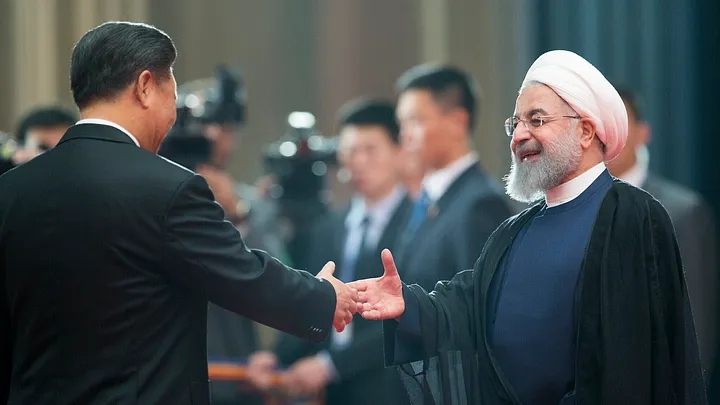
Iran-China: The Lion And Dragon Pact

Hassan Rouhani and Xi Jinping greet each other|Alexander Zemlianichenko
India and Iran have an “alphabetical dividend” in the United Nations. We get to be seated very near each other in most of the multilateral bodies.
During the Iran-Iraq war, some ingenious Secretariat staff used to manipulate the seating in such a way that we found ourselves between the Iranian and Iraqi delegations.
At the International Atomic Energy Agency (IAEA) Board of Governors, I sat next to the Iranian delegates, ranging from junior diplomats to Ministers and high level nuclear experts for nearly four years. Some of them are at the highest levels in the nuclear establishment and elsewhere in the Iranian government today.
From that experience, I have felt that the special relationship between India and Iran is one of the foreign policy myths in India. Iranians are very sophisticated, cultured and cordial, but they are hard headed pragmatists, for whom Islamic blood, particularly the Shia variety, is thicker than civilizational links.
They have a certain admiration for India, but when it comes to Pakistan, they have to stick to the OIC formula. After every OIC diatribe against India, they look sheepish and hide behind the convention that consensus could not be broken. They, like others, are willing to mediate on Kashmir rather than acknowledge it as an integral part of India. Even on other international issues, there is no automaticity of Iranian support to India.
Iran has, however, a Shia following in India, which is influential in government, journalistic and intellectual circles and is confident of Indian support to Iran on crucial issues.
Iranians have a good equation with the western countries, particularly the Europeans, notably Germany and they negotiate hard and long with them.
They will seek the help of India and other non-aligned countries when they are stuck with the west to demonstrate that they have a constituency. But if we do not meet their expectations, they move heaven and earth in the government in India and finally complain bitterly and threaten reciprocal action if we do not support them.
India’s vote in the IAEA Board to refer the Iran nuclear issue to the UN Security Council angered them to such an extent that they were willing to break negotiations on oil supplies. At one point, I had to stay out of the consensus on Iran of the non-aligned group in Vienna and within minutes, my Iranian colleague set the Ganges on fire to make me budge. I could not, because it was against the long-held position of India on non-proliferation.
I was, therefore, not surprised when the news of a forthcoming long term economic and strategic partnership between Iran and China leaked, followed by easing out of India from the Chabahar to Zahedan rail line.
Iran decided to play the China card finally against the US and India, having kept the option open even when Iran made concessions to the US to escape crippling sanctions.
Iran has had a long history of good relations with both China and Russia even as it maintained that it would not go with either the east or the west. China was the largest source of weapons for Iran during the long Iran-Iraq war and China had become Iran’s largest trading partner in 2010. China used to buy 34% of its oil from Iran with special financial arrangements, including barter.
After its last -ditch effort to escape sanctions by signing a suicidal nuclear deal, Iran has decided to look and act east. They have chosen China over India and Russia. But Iran will use its pivot to the East for its own advantage and not to be subservient to China.
China’s Belt and Road Initiative (BRI) had presented a dilemma to Iran. On the one hand, they felt that BRI would bring some stability to its neighbourhood, but on the other hand, feared that it would lead to Chinese domination in the region and beyond. It was also feared that Chinese links with the Central Asian region would impact Iranian interests in there.
But Iran seems to have reconciled to the inevitability of BRI to counter the US as the constructive engagement with the US has ended. India’s increasing links with the US has made China more attractive to Iran in its adjustment with the shift in global power equations. Indications of the new approach was visible in the Iranian position on Kashmir and the Delhi riots at the time of the visit of President Trump.
China’s concern about the Iranian nuclear deal was palpable when President Xi visited Iran in 2016 as it appeared that Iran would slip into the hands of the west and distance itself from China. Xi is reported to have offered Chinese investments in Iran and even intelligence sharing in the new context of Iran’s nuclear activity.
Now that Iran has abandoned the nuclear deal and started its enrichment activities, Chinese support is crucial in the IAEA and the UN Security Council. Iran has also shown interest in becoming an observer in the Shanghai Cooperation Organization (SCO). Under the projected Comprehensive Strategic Partnership Agreement, China would commit to invest USD 400 billion in the next 25 years.
As Iran appeared to be facing international isolation, the China linkage was necessary to satisfy the domestic opinion in Iran. Interestingly, the Iranian decision to scrap the railway deal with India came at a time when China started a border conflict with India.
Even while there was speculation that the Chinese action was turning out to be a “Himalayan Blunder”, which Indian observers have lapped up, the Iranian agreement must have come as a morale booster for China. Iran had originally criticized China on its handling of the corona virus, but later apologised when it found that China was taking any criticism as an inimical act.
China expects abject obedience from its allies. With Iran on its side, Chinese penetration into West Asia, marked by its strong ties with Saudi Arabia and Israel has become deeper.
A conservative Iranian newspaper linked to the Iranian Royal Guards characterised the Iran-China agreement as “the Lion and Dragon Pact”, making it qualitatively and symbolically more significant than Iran’s other relationships.
By virtually abandoning India, which has been diluting American ire against Iran, it is pushing India into the American camp, just as China is doing the same by flexing its muscles on the India-China border.
Perhaps, Iran needed India more than India needed Iran. Still, our plans for West Asia and Central Asia will suffer a setback because of the embrace of the lion and the dragon.
We shall have to work our way around the new partnership between Islamic fundamentalism and Communist Capitalism.
Ironically, China and Iran will push India towards the US and the Quadrilateral.
